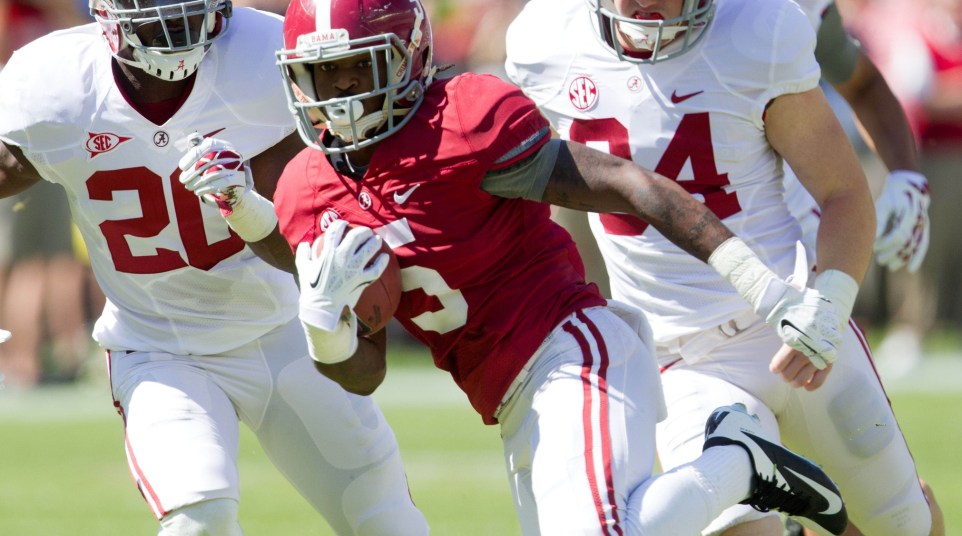Post-spring strengths and weakness: Alabama
As they are every season, the Alabama Crimson Tide are one of the early favorites to win the SEC in 2015. This iteration of the Tide seems to have more questions than most, though.
On both sides of the ball, Alabama has strengths and weaknesses that can alternately propel them to a repeat title or knock them back in the ever-crowded SEC West.
Coming out of spring practices, where do those strengths and weaknesses stand?
Strengths
- Front seven play — It’s no surprise that Alabama will once again field stacked groups at both linebacker and defensive line. Standouts Reggie Ragland, Jarran Reed and A’Shawn Robinson all return to lead a front seven that returns five starters from last year after leading the SEC in run defense. With Reuben Foster and Shaun Dion Hamilton stepping up at middle linebacker for Trey DePriest, Ryan Anderson taking on a bigger role with Xzavier Dickson departing and Da’Shawn Hand being added to the mix as a pass rusher, the front seven shouldn’t miss a beat.
- Wide receiver depth — We’re well aware that Amari Cooper, Christion Jones and DeAndrew White have all moved on. Even so, Alabama’s receiving corps is too deep and talented for there to be much to worry about. Even with Cam Sims going down with an ACL tear, there are still plenty of players ready to step up and become playmakers for the Crimson Tide. Robert Foster, ArDarius Stewart, Chris Black, Kenyan Drake (who will likely spend some time splitting out wide) and incoming freshman Calvin Ridley all bring a great amount of talent and versatility to the group and should provide whoever Alabama’s quarterback is with a variety of weapons.
- The field position battle — Add the first two ingredients, the linebackers and defensive linemen that form one of the nastiest front-seven groups in the country, to one of the best punters in the country in JK Scott. (No, we’re not the ones who called Paul Finebaum to talk about Scott last week, but the kid is one of the best special teams weapons in the country.) What do you get when you add those factors together? Opposing offenses facing long fields and the rebuilding Alabama offense working with good field position. The Crimson Tide offense will undoubtedly come together by fall, and it’ll have some time gel thanks to the team’s defensive and punting prowess.
Weaknesses
- Quarterback uncertainty — The Crimson Tide faced the same issue last year after Blake Sims struggled in the spring game, which turned out to be a non-issue by fall. This year, with no fifth-year senior around, things are a little shakier. There’s a chance that Nick Saban is employing some motivational techniques to light a fire under presumed starter Jacob Coker by saying there’s no separation between him and the field at quarterback. Regardless, Alabama goes into the summer without a steward for the offense. Be it Coker, David Cornwell, Alec Morris or Blake Barnett, the sooner Saban and Lane Kiffin are able to settle on their passer, the better.
- Running back depth — This was supposed to be a strength for the Crimson Tide. That was before Altee Tenpenny transferred to UNLV, Tyren Jones was suspended and then dismissed and Bo Scarbrough tore his ACL. Alabama still has two excellent running backs in Derrick Henry and Drake, but the offense will be forced to rely on two true freshmen, Damien Harris and DeSherrius Flowers, something the coaching staff certainly didn’t foresee as the 2014 season came to a close.
- Questions in the secondary — Outside of quarterback, no area has more question marks than the secondary, leaving Mel Tucker with his hands full. Safety Geno Smith is the most experienced member of the group, but he was arrested this offseason for DUI, leaving his status for fall uncertain. His absence during spring opened up reps for Hootie Jones, Jabriel Washington and Ronnie Harrison, which could be a positive development. Cornerback Cyrus Jones missed the entire spring, while Eddie Jackson was shuffled between corner and safety. Alabama has plenty of depth at the position, but it still has to be sorted out.

